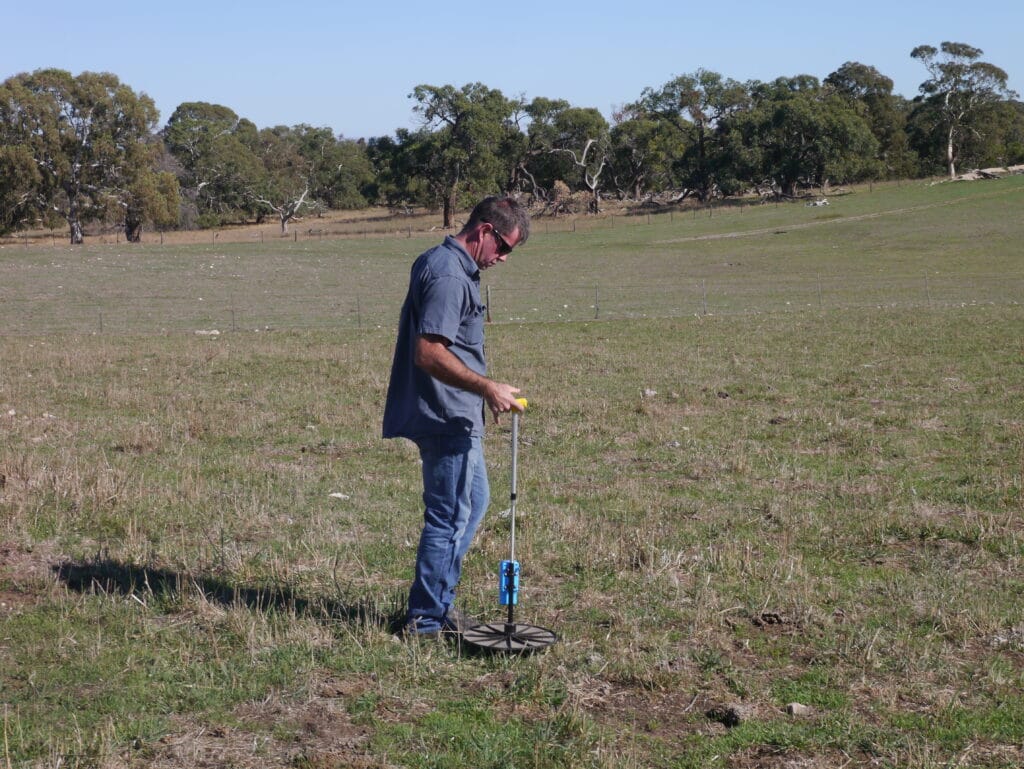Measuring feed on offer for better grazing management

Feed on offer (FOO) is the amount of pasture available for grazing, measured in kilograms of dry matter per hectare (kg DM/ha). The amount of FOO you need varies depending on stock and production goals, and of course seasonal conditions, but knowing your FOO is crucial for every producer looking to maximise output in a sustainable way. It’s central to feed budgeting, helping you to get the most out of your pasture while avoiding overgrazing.
There’s a range of ways to measure FOO. Some give only rough estimates, while emerging technology is providing more accuracy and reliability in your records leading to data driven decisions.
Techniques for measuring FOO
- Visual assessment
- Pasture rulers
- Quadrat cuts
- Rising plate meters
- Electronic pasture probes
- Electronic pasture meters
- Satellite-assisted pasture measurement
- Tracking FOO with AgriWebb
Visual assessment
Whether it’s a glance out the ute window or measuring the pasture against your boots, a quick visual assessment is one of the most widely used methods to judge FOO. And if we’re honest, it’s also one of the most unreliable.
Government departments and industry organisations have photo standards that assist with visual assessments. You can also create your own, by keeping photo records when you take quadrat cuts (see below). But even with photo standards, you’re left making rough estimates about one of your most valuable assets.
Pasture rulers

Pasture rulers such as the MLA Pasture Ruler are cheap, simple devices for measuring pasture. Benchmarks on the ruler allow a quick assessment of whether pasture conditions are meeting the needs of your livestock. You do need to make corrections for pasture density and moisture content, as without doing this your feed estimate will be far less reliable.
Quadrat cuts
One accurate way to work out how much FOO you have is to measure a sample. A quadrat is a small frame used to select a sample of vegetation, which you cut, dry and weigh. With samples from several locations across a paddock, you can get a good reflection of the pasture condition. This technique is the most time consuming but it gives you information you can use to calibrate other measurement methods.
Rising plate meters

Rising plate meters squash a selection of pasture beneath a weighted disc and measure the compressed height. The higher the plate sits from the ground, the taller and denser the pasture. To work out FOO with a rising plate meter, you take dozens of measurements across each paddock. The meter tabulates and averages these numbers. A formula – which can be based on your pasture cuts – converts the average reading for a paddock into an assessment of dry matter per hectare.
Electronic pasture probes
Like rising plate meters, pasture probes involve walking through fields taking multiple measurements, but they use more sophisticated technology. A low-voltage electric field spreads out from the probe into growing material nearby. Changes in the electric field, related to the water mass of plant material it comes across, allow dry matter per hectare to be calculated. It does become less accurate if pasture is wet with dew or rain.
Electronic pasture meters
Electronic pasture meters are mounted or towed by vehicles. The Australian-made Automatic Pasture Reader, which uses sonar sensors to measure pasture height, is attached to a vehicle. The C-Dax Pasture Meter, developed in New Zealand, is towed on a sled by a quad bike and uses infrared light. Both take hundreds of measurements a second to determine pasture height. This data is used to calculate kilograms of dry matter per hectare.
Satellite-assisted pasture measurement
Advancements in the accuracy of satellite imagery now allows for remote measurement of pastures. This offers a huge advantage over other techniques for measuring FOO, as you can keep on top of rapidly changing pasture yields and the wide variance between paddocks.
Companies like Cibo Labs combine satellite imagery with machine learning and on-farm knowledge. Instead of spending hours driving around your property to see the state of play, you only need to review your phone for unrivalled insight into pasture productivity.
Tracking FOO with AgriWebb
When FOO is recorded in AgriWebb, the data is used to calculate grazing days remaining, allowing for better pasture management, stocking rate optimisation and paddock rotation decisions. Our integration with Cibo Labs means this data can be automatically updated with new satellite information every five days.
Between them, Cibo Labs’ founders have more than 50 years of experience in pasture imagery and analysis. The company uses new approaches to machine learning with multi-spectral imagery at 10-metre resolution, and can calibrate results to quadrat cuts from your farm for extra accuracy.
By monitoring pasture status and groundcover weekly, you can determine sustainable stock numbers and reduce the risk of feed shortages. You’re also better placed to make decisions should conditions change, meaning a more resilient operation in tough times.
Ready to dive deeper into your grazing? Download our latest grazing guide, Profitable pastures: a guide to effective grazing management!


